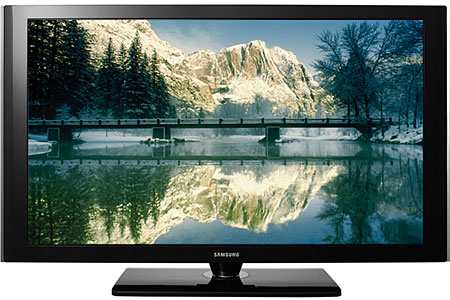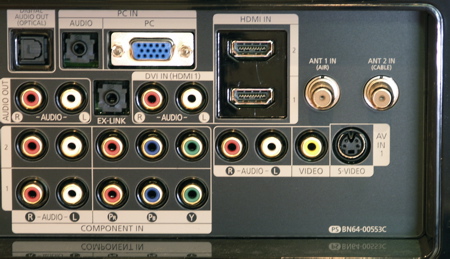Samsung FP-T5884 Plasma TV

Of course, Samsung is a major player in the LCD arena, but the company still makes an extensive line of plasma sets as well. The FP-T5884 ($4000) is one of its two 58-inch plasma models; the other is the FP-T5894 ($4600), which adds wireless A/V connectivity, but its specifications are otherwise identical.
Features
Overall, the Samsung's feature set is not unusual. It offers the normal picture adjustments and an assortment of "special" controls, some of which are useful to a degree, others not so much, especially for those who want the most accurate picture they can get. Among the less-useful settings are My Color Control (color adjustments that normally lead to less-accurate colors), Active Color (automatically adjusts colors, rarely to good effect), and DNIe (Digital Natural Image Engine, Samsung's picture-enhancement processor that, in my experience, does more harm than good). In any case, Active Color and DNIe are not available in the Movie picture mode, which I used for virtually all my viewing and testing.
The user menu also includes White Balance controls, which are used to adjust the grayscale. However, these should be tweaked only by an experienced calibrator with the appropriate test equipment.
The FP-T5884 will accept signals up to 1080p at 60 or 24Hz via HDMI; the component input can accept 1080p/60. Unfortunately, the set converts 1080p/24 to 60Hz for display by applying 3:2 pulldown, eliminating the benefit of having a 1080p/24 source. There aren't many plasmas (or other displays) that show 1080p/24 correctly—that is, at a multiple of 24Hz, which results in smoother motion from film-based content.

The side-mounted USB port, dubbed WiseLink, can be used to feed MP3 audio and JPEG photos from a storage device to the TV. It also serves as a connection point for possible future updates to the set's firmware.
Burn-in is an issue for any plasma display, but most modern models are far less susceptible to it than earlier generations. Ghostly imprints of stationary elements, such as game scoreboards or news tickers, can linger if such images are left on the screen for a long time. Also, letterboxed or windowboxed areas can become evident if you only watch 4:3 TV or letterboxed movies. Samsung provides several features to combat urn-in, including pixel shift (lets you move the image around by a few pixels horizontally and vertically), full white field, scrolling (moves all pixels around in a pre-determined pattern), and gray sidebars for 4:3 images.
Like all plasmas, the Samsung's glass screen can act as an inefficient mirror in a well-lit room. The set can be rotated by about 20 degrees in either direction, which can help minimize annoying room reflections.
I was not impressed with the set's audio, most of which is squeezed through a narrow gap at the sides of the cabinet. But you might find it acceptable for casual use, particularly if you use the headphone jack to bypass the small speakers that limit the audio performance of this and most other flat-panel displays.
The 82-page, single-language manual is thorough and helpful—a worthwhile read, though hardly a page-turner. Like most such manuals, it's better at explaining how to make various adjustments than why you might want to. In fairness, offering such explanations in a comprehensible way would probably result in a 150-page manual and lots of glazed-over eyeballs.













































